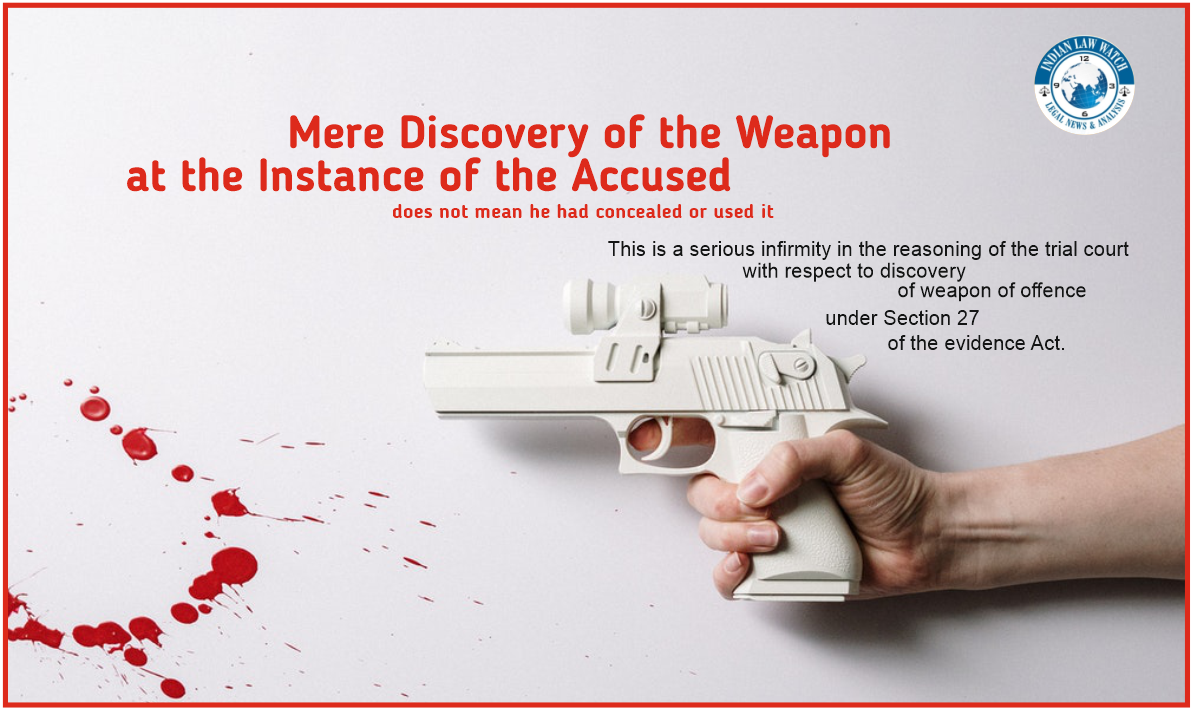

ORDER PASSED
The Supreme Court in Shahaja @ Shahajan Ismail Mohd. Shaikh v. State of Maharashtra, Criminal Appeal 739 of 2017 while upholding the conviction of person convicted under Section 302 of the Indian Penal Code, observed that merely because discovery of weapon was at the instance of accused, it does not mean he had concealed or used it. The court also examined Section 8 of the Evidence Act and observed that conduct of the accused alone form the basis of conviction.
In this case, although the Apex Court agreed with the observations of the lower courts, it deemed fit to point out a serious infirmity in the reasoning of the trial court as affirmed by the High Court with respect to discovery of weapon of offence under Section 27 of the evidence Act.

Section 27- Evidence Act
Section 27 of the Act lays down that if the accused makes a confession, it could be used to prove a fact or the discovery of new facts in the investigation. Such confession would be admissible in the court of law even if it was obtained under threat or promise.

The Court relied on Kirshnappa v. State of Karnataka : AIR (1983) SC 446 and Mohmed Inayatullah vs The State of Maharashtra: AIR (1976) SC 483to note down the conditions necessary for the application of Section 27 of the act, these are:
(1) information must be such as has caused the discovery of the fact; and
(2) information must relate distinctly to the fact discovered
(3) Discovery of such fact to be deposed to;
(3) The accused must be in police custody when he gave the information.
The Court further relied on Dudh Nath Pandey v. State of UP [AIR (1981) SC 911] and observed the testimony on record to note that mere discovery cannot be interpreted as sufficient to infer authorship of concealment by the person who discovered the weapon as such knowledge of the existence of that weapon at the place could have been derived by the person through some other source. Therefore, it cannot be presumed or inferred that because a person discovered the weapon, he was the person who had concealed it, least it can be presumed that he used it.
Regarding the present case, even if discovery by the appellant is accepted, what emerges from the substantive evidence as regards the discovery of the weapon is that the appellant disclosed that he would show the weapon used in the commission of the offence.
The court also elaborated upon the role of panchnama and noted that the trial court committed an error by not taking the pains to see that the panchnama was read over to the panch before it was exhibited.
 The court stated that
The court stated that
“a panchnama which can be used only to corroborate the panch has to be read over to the panch and only thereafter it can be exhibited. If the panch has omitted to state something which is found in the panchnama, then after reading over the panchnama, the panch has to be asked whether that portion of the panchnama is correct or not and whatever reply he gives has to be recorded. If he replies in the affirmative, then only that portion of the panchnama can be read into evidence to corroborate the substantive evidence of the panch. If he replies in the negative, then that part of the panchnama cannot be read in evidence for want of substantive evidence on record.”
The court noted that the trial court must see if such a procedure has been followed, i.e., panchnama is read over the panch and thereafter the panchnama is exhibited after following the procedure as indicated above.
For Section 8 of the Act, the court noted that the conduct of an accused is one of the circumstances that the court may take into consideration along with the other evidence on record, direct or indirect. However, the conduct of the accused alone, though may be relevant under Section 8 of the Act, cannot form the basis of conviction.





